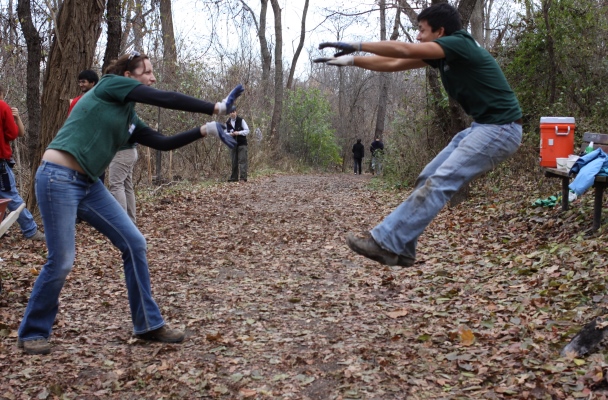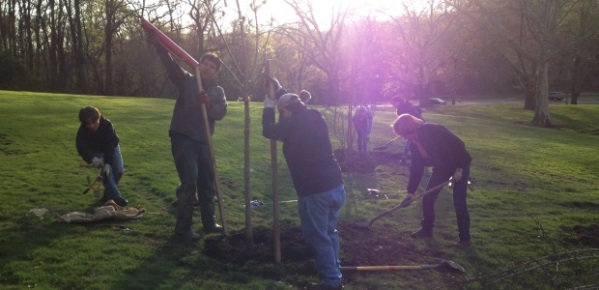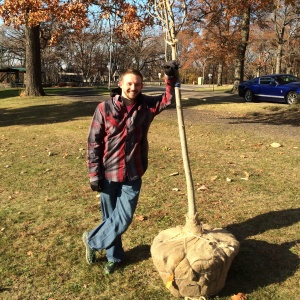This post was originally written and posted by our friends at Venture Outdoors. Check out their blog here!
On December 24, Parks Conservancy Naturalist Educator Mike Cornell will be leading his third annual, all-ages winter hike through Frick Park.
In 2012, Cornell led his first hike on a whim. He was in the office on December 24, Christmas Eve, and decided that if had to be in office, he would see if anyone wanted to come out for a hike. He put up a posting on Facebook: “Gonna take a hike at noon.” Approximately eight to 10 people showed up and a tradition was born. This year, the Pittsburgh Parks Conservancy expects between 25-30 people. The hike has become so popular so quickly that they are hoping to do another winter hike in January 2016.
Cornell’s outdoors education has spanned most of his life. Since he was 15, he worked on education and hikes with the Frick Environmental Center. Growing up in Point Breeze meant that Cornell was always out and about.
“I’ve been going outside my whole life and I just want to share it with other people,” Cornell said. “It’s so great to show others what is so great about the outdoors and what they can see out in the woods.”
Cornell went to school in Syracuse at the SUNY College of Environmental Science and Forestry, where he studied environmental science in natural history and interpretation. During summers, he would return to Pittsburgh to work in the parks at the Frick Environmental Center.

Photo: Mark Simpson
Nowadays, Cornell prepares for his hikes well ahead of time. When he first begins to create a hike, he imagines what it will look like: will he try to get as far possible, cover as much ground as he can? Will he try to educate his audience on trees or birds? It is essential for him to pick a topic for the hike. Once he chooses a topic, he narrows it down to a specific theme or anchor.
“For instance, I really like winter tree ID hikes; I always default to trees!” Cornell said. “What am I going to do to make it interesting this year?”
He looks at ways to make the winter tree ID hike interesting, like educating his audience on which trees can be used to make a winter tea.
“Maybe we’ll walk around the park and sample teas from different types of trees,” Cornell said. “We could talk about additional properties, like, historically speaking, how trees were used for tea and to get people through harsh winters.”
Once he locks down his theme or anchor, he takes to the route. Cornell explores and walks potential paths and figures out the different things he wants to show his audience.
“I make sure I can see the trees I want to see or I check out the best place to see birds or fossils,” Cornell said.
Sometimes he charts out his route on a map to get exact distances and times.
“I like to start and end when I say I will,” Cornell said.

Photo: Melissa McMasters
Though he may mimic past hikes’ theme, no one hike is the same. Every outdoors experience offers a unique perspective or a surprising event. This past summer, for instance, Cornell was out in the early morning for a run and ran into a six-point buck in the middle of the trail. He had seen other bucks playing around the area in earlier weeks. The buck approached Cornell as he stood very still. The buck turned sideways and gently bumped Cornell with his antler.
“It was like he was waiting for me to come after him,” Cornell said, “So I gently tapped him on the back and then he tapped me. I had a little game of tag with a deer and it was so surreal.”
From planning hikes to leading them, it seems Cornell is out in the parks enough that even the deer and bucks have taken a liking to him.
– Danielle Levsky, Communications and Media Coordinator at Venture Outdoors
Though the upcoming winter hike is now closed for registration, check back with us at the Parks Conservancy to see when Mike will host his next hike. Also, check out Venture Outdoors’ upcoming hikes, like the New Year’s Resolution Hike on January 1, the Game Day Hike on January 3 and the Winter Tree ID Walk on January 9.


 Beech
Beech
 Sassafras
Sassafras London plane
London plane Dawn redwood
Dawn redwood
















